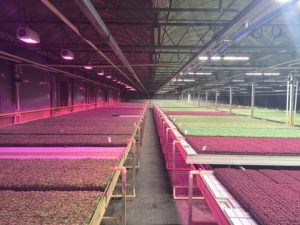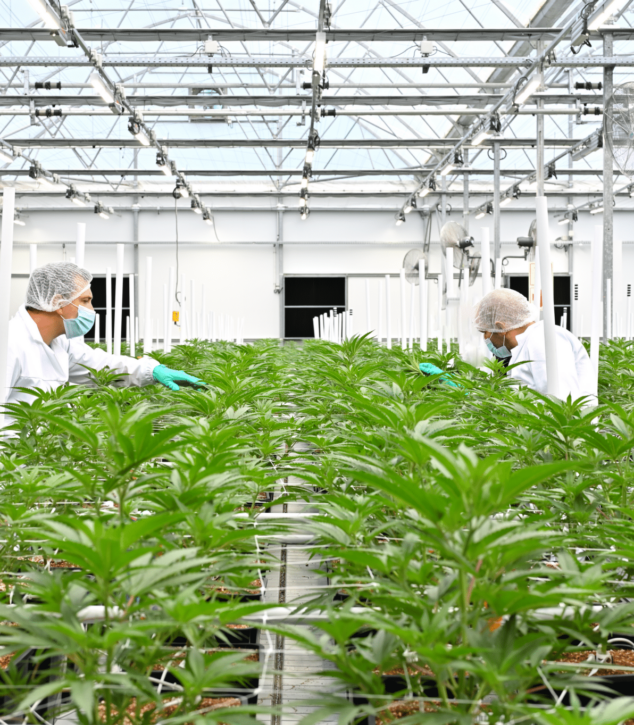We have known that light is responsible for driving plant growth via photosynthesis for many years; however, the influence of light on plant development has only become well understood in the last century. The color of light (spectral light quality) is not only an important variable for photosynthesis, but also acts as a packet of information to signal light mediated developmental responses in plants, such as: seed germination, stem elongation, and flowering. The term used to describe these responses in plants is photomorphogenesis (photo = light, and morphogenesis = the process that causes an organism to develop its shape). Plant morphology (plant architecture) is extremely important in controlled environment agriculture where vertical or horizontal growing space may be limited. Depending on the plant architecture you desire, there may be other aspects of horticulture lighting systems to consider beyond providing a source of photosynthetic light.
Photosynthetically active radiation (400 – 700 nm) is mainly used for photosynthesis, however, plants can sense wavelengths ranging all the way from UV-C (260 nm) to far-red (730 nm) using separate photoreceptors that are not utilized for photosynthesis. These photoreceptors direct an adaptive response in plants under changing environmental conditions to regulate key stages of plant development which depend strongly on the spectrum of light, and in some cases timing, periodicity, and the overall exposure. The latter is usually called fluence, and is measured in micromoles of photons per square meter of surface. There are very low, low, and high fluence responses, with the corresponding sufficient light levels ranging from those of star light (for very low) to direct sunlight (for high). The purpose of this article is to describe photomorphogenic responses in plants to help you consider.
Red & Far-Red Light Responses
When it comes to photomorphogenesis, the most understood developmental processes are those controlled by red and far red light (for the purposes of this discussion, we will refer to red (R) light as the spectral region around 660 nm and far red (FR) light around 730 nm). In order to better understand the influence that these two spectral regions have on plant development, you need to first understand the significance of the pigment known as phytochrome, which is responsible for R and FR light mediated responses.
Phytochrome is a pigment protein which exists in two interconvertible forms – a red light absorbing form (Pr) and a far red absorbing form (Pfr). Phytochrome converts from one form to another upon absorbing the corresponding light until an equilibrium is established (phytochrome photoequilibrium), with the relative amount of each form depending primarily on the ratio of R to FR light in the light spectrum. To put this another way, when Pr absorbs R light it is converted into Pfr, and when Pfr absorbs FR light it is converted into Pr (There is some overlap in in the spectra of both forms, and phytocrome does absorb some blue light as well, but for the sake of this guide, this will not be discussed). The prevalence of one form or the other (which depends on the R/FR spectral ratio) can stimulate or inhibit a number of developmental processes such as: seed germination, leaf unrolling, chlorophyll formation, and stem elongation. Additionally, phytochrome is the controlling factor of promoting (or suppressing) flowering in photoperiodic plant species. For the sake of brevity, and to discuss important applications related to horticulture lighting systems, we will focus on the influence that phytochrome has on flowering and stem elongation.
Photoperiodism
There are long-day plants (which require short nights to flower), short-day plants (requiring long nights), and day-neutral plants which have no specific requirement for the photoperiod. This dependence on the photoperiod is referred to as photoperiodism, however, it is actually the length of the dark period (skotoperiod) that regulates flowering of photoperiodic plant species. In the absence of light, Pfr slowly converts to Pr, and as the skotoperiod increases, so does the relative amount of Pr. Long day plants (which have a short skotoperiod) will not flower if Pfr converts to Pr during the skotoperiod, while short day plants (which have a long skotoperiod) will only flower if Pfr converts to Pr during the skotoperiod. Photoperiodic phytochrome responses occur in the low fluence range (as low as 1 µmol/m2), so it can only take a short flash of R light to during a skotoperiod to revert Pr back to Pfr. For example, flowering of a long-day plant may be induced by night interruption, using a series of short flashes of red light with photon flux levels as low as a few µmoles/m2/s. Conversely, short-day plants may be induced to flower by a single flash with pure FR light at the very beginning of the dark photoperiod, after turning off all other lights. This effectively adds a couple of hours to the dark period for the purpose of flowering, which can be used to extend the light period for growth and optimize plant yields as a result. Switching the above methods for plants with opposite photoperiod requirements would delay flowering, which may also be desired sometimes (e.g. to provide the best quality flowers on schedule for certain holidays).
A good energy-saving (and thus, cost-saving) strategy is to use one set of lights for growth and another for photoperiod control when necessary. Since phytochrome response is in the low fluence range, the number of fixtures needed for photoperiod control may be much smaller than that of fixtures needed for growth. In addition, the operating time needed for photoperiod control can be much shorter, such as only minutes at a time. Since FR light is only partially photosynthetically active, its use in horticulture lighting is often limited for reasons of energy efficiency.
Shade Avoidance Response
Another important R and FR photomorphogenic response important to horticulture lighting systems is called the shade avoidance response. Far-red light is transmitted through leaf tissue more so than red light, which causes an enrichment of far-red light, relative to red light, for plants grown under canopies. When a low R:FR ratio is perceived by phytochrome pigments, a shade avoidance response is activated to elongate hypocotyls or stems in an attempt to out-compete neighboring plants. This is very important when it comes to the spectral light quality of horticulture lighting systems. Photoperiodic lights that provide a low R:FR ratio to promote flowing may also induce a shade avoidance response in plants, which may result in an undesirable growth habit (especially if a compact growth habit is preferred).
Blue & Green Light Response
Blue Light Response
Two important blue light photreceptors are cryptochromes and phototropins. Blue light is important for a variety of plant responses such as: suppression of stem elongation, phototropism (bending towards a light source), chloroplast movement within cells, stomatal opening, and activation of gene expression (some of these are morphogenic and others aren’t). Stomatal opening and height control are of particular relevance to horticulture lighting systems. A low overall content of blue light in the growth spectrum (e.g. less than 10% of the total photon flux) can lead to leaf edema (swelling of the leaves) and developmental problems in several plant species. The absolute content of blue light has a progressively stronger effect for plant height reduction. This may be desirable in some cases (e.g. to produce more compact seedlings and reduce transportation costs) but generally leads to a lower photosynthetic efficiency of the light with respect to energy consumption. A high relative content of blue light reduces the plant leaf area and may be undesirable for that reason. Near UV light has an effect similar to blue light, with further reduced photosynthetic efficiency, especially below 400 nm (although the other effects may be stronger by comparison). It also affects the biosynthesis of compounds responsible for the flavor of certain fruits, increased anthocyanin concentration, as well as that of other compounds which are not directly produced by photosynthesis alone. Whenever the use of near UV light is necessary to control a corresponding sensory mechanism or the production of a specific molecule of interest by the plant, an overall efficiency trade-off may have to be reached, similarly to that for the use of far red light.
Green Light Response
The least understood spectrum related to photmorphogenic responses in plants is green light (500 – 600 nm). The control effects of green light are generally opposed to those of red and blue light. For example, green light has been shown to reverse blue light induced plant height reduction and anthocyanin accumulation. The phytochrome and cryptochrome photoreceptors mentioned earlier are also responsive to green light, though to a significantly lesser extent than to red or blue light. So far, all efforts by researchers to find photoreceptors responding primarily to green light have given no definitive results. However, it should be mentioned that the addition of green light into the spectrum of horticulture lighting systems has demonstrated to be beneficial to the growth of several plant species. Similar to far-red light, green light penetrates deeper into leaves and canopies than red or blue light, and can significantly increase the rate of photosynthesis. The addition of green light also significantly improves the color rendering index (CRI) of a horticulture lighting systems, which allows growers to effectively monitor crops for disease or nutrient deficiency/toxicity symptoms, without the use of specialized glasses.
Conclusion
In horticulture lighting systems, there is a number of choices – especially when it comes to using LED lights, which can range from narrow-band spectral composition (i.e. pink or purple) to broad spectrum (often referred to as white). Depending on the crop you are producing, selecting an LED horticulture lighting system with the appropriate light quality is critical, not only to drive photosynthesis, but to achieving desired morphological responses. Fluence PhysioSpec Indoor and Greenhouse were customized to provide the best photosynthetic and photomorphogenic responses to a variety of plant species. Fluence also provides custom light spectra to trigger photomorphogenic responses.






